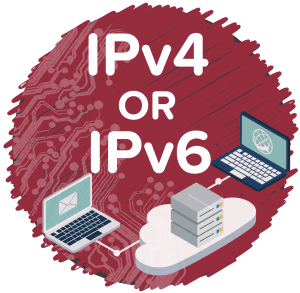An Internet Protocol address is also known as an IP address. It is a numerical label assigned to each device connected to a computer network that uses the IP for communication.
IP address act as an identifier for a specific machine on a particular network. The IP address is also called IP number and internet address. IP address specifies the technical format of the addressing and packets scheme. Most networks combine IP with a TCP (Transmission Control Protocol). It also allows developing a virtual connection between a destination and a source.
IPv4...?
IPv4 was the first version of IP. It was deployed for production in the ARPANET in 1983. Today it is the most widely used IP version. It is used to identify devices on a network using an addressing system.
The IPv4 uses a 32-bit address scheme allowing to store 2^32 addresses which is more than 4 billion addresses. Till date, it is considered the primary Internet Protocol and carries 94% of Internet traffic.
IPv6...?
It is the most recent version of the Internet Protocol. Internet Engineer Taskforce initiated it in early 1994. The design and development of that suite are now called IPv6.
This new IP address version is being deployed to fulfill the need for more Internet addresses. It was aimed to resolve issues that are associated with IPv4. With 128-bit address space, it allows 340 undecillion unique address space. IPv6 also called IPng (Internet Protocol next generation).
Difference in IPv4/IPv6
| Basic differences | IPv4 | IPv6 |
|---|---|---|
| Address | 32 bits (4 bytes) 12:34:56:78 | 128 bits (16 bytes) 1234:5678:9abc:def0:1234:5678:9abc:def0 |
| Packet Size | 576 bytes required, fragmentation optional | 1280 bytes required without fragmentation |
| Packet Fragmentation | Routers and sending hosts | Sending hosts only |
| Number of header fields | 12 | 8 |
| Length of header filed | 20 | 40 |
| Type of Addresses | Unicast, broadcast, and multicast. | Unicast, multicast, and anycast. |
| Number of classes | IPv4 offers five different classes of IP Address. Class A to E. | lPv6 allows storing an unlimited number of IP Address. |
| Configuration | You have to configure a newly installed system before it can communicate with other systems. | In IPv6, the configuration is optional, depending upon on functions needed. |
| Routing Information Protocol (RIP) | RIP is a routing protocol supported by the routed daemon. | RIP does not support IPv6. It uses static routes. |
| SNMP | SNMP is a protocol used for system management. | SNMP does not support IPv6. |
| Security | Security is dependent on applications - IPv4 was not designed with security in mind. | IPSec(Internet Protocol Security) is built into the IPv6 protocol, usable with a proper key infrastructure. |
| DNS records | Address (A) records, maps hostnames | Address (AAAA) records, maps hostnames |
| IP to MAC resolution | Broadcast ARP | Multicast Neighbour Solicitation |
| Local subnet Group management | Internet Group Management Protocol GMP) | Multicast Listener Discovery (MLD) |
| Combability with mobile devices | IPv4 address uses the dot-decimal notation. That's why it is not suitable for mobile networks. | IPv6 address is represented in hexadecimal, colon- separated notation. IPv6 is better suited to mobile networks. |
| Mobility & Interoperability | Relatively constrained network topologies to which move restrict mobility and interoperability capabilities. | IPv6 provides interoperability and mobility capabilities which are embedded in network devices. |
| IPSec | Internet Protocol Security (IPSec) concerning network security is optional | Internet Protocol Security (IPSec) Concerning network security is mandatory |
| Dynamic host configuration Server | Clients have approach DHCS (Dynamic Host Configuration server) whenever they want to connect to a network. | A Client does not have to approach any such server as they are given permanent addresses. |






No comments:
Post a Comment